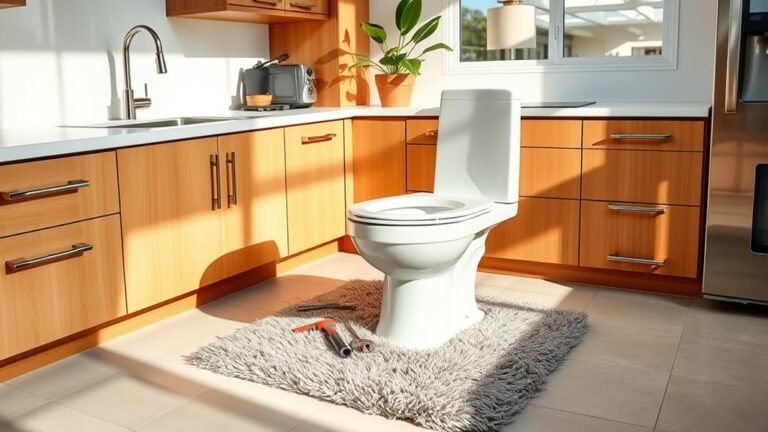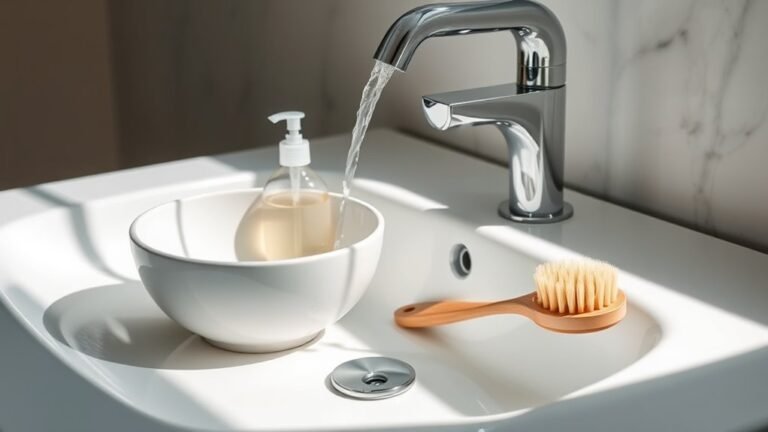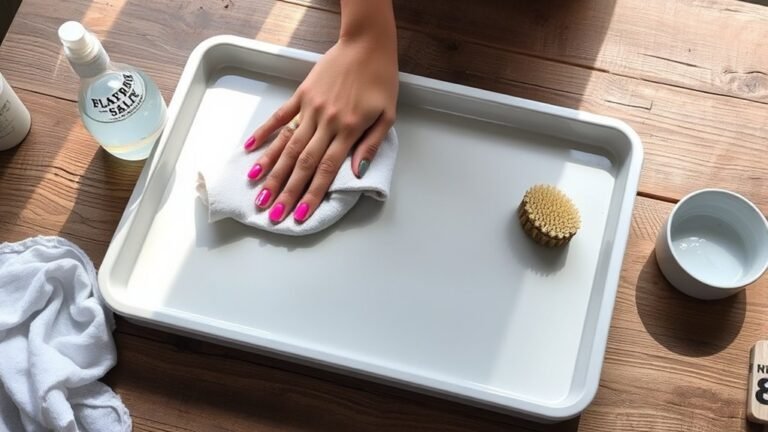How to Clean Pool Tile Calcium
To clean calcium buildup from pool tiles, gather protective gloves, goggles, a durable scrub brush, pumice stone, and acidic cleaner. First, apply the cleaner generously to affected areas and let it sit briefly. Scrub the tiles in circular motions, focusing on stubborn spots with the pumice stone, being careful to avoid scratches. Rinse thoroughly with clean water. Establish a regular maintenance routine to keep your tiles clean and shiny. You’ll discover more effective long-term tips soon.
##
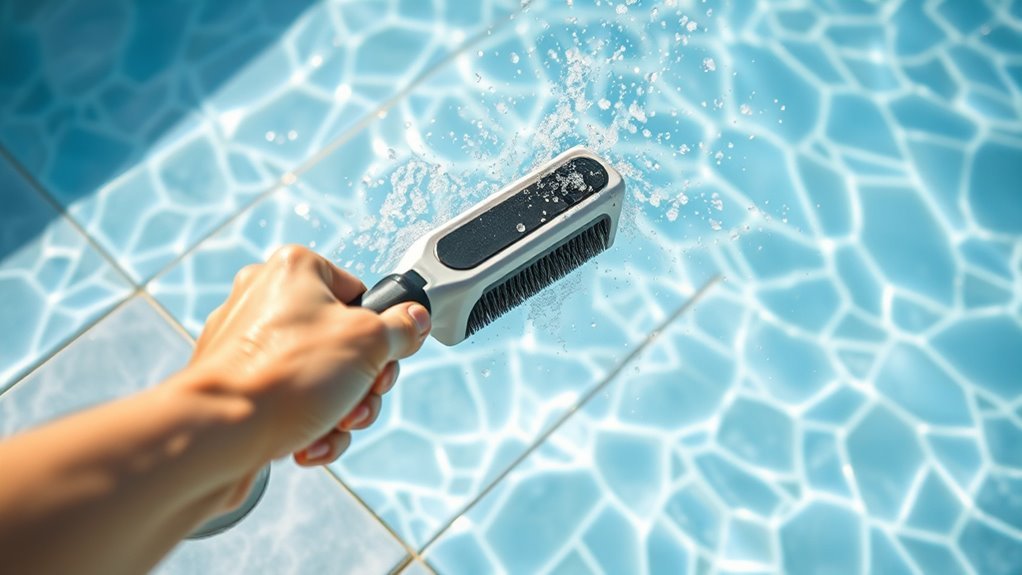
If you’re looking for effective ways to tackle calcium buildup on your pool tiles, you’re in the right place. This article provides a comprehensive guide to understanding the nature of calcium deposits and offers practical tips for maintaining your pool’s appearance. By establishing a regular cleaning routine and addressing any issues promptly, you’ll not only enhance the beauty of your pool but also prevent more significant problems down the line. Read on to discover the best methods for keeping your pool tiles sparkling clean and free from stubborn calcium stains.
Preparation For Cleaning
Before diving into the cleaning process, it’s crucial to gather the necessary tools and materials to guarantee an efficient and effective job. Start by reviewing your maintenance schedule; regular upkeep can prevent heavy calcium buildup. Identify the cleaning methods you plan to use, whether it’s a scrub brush, vinegar solution, or a specialized cleaner. Make sure you’ve got safety gear like gloves and goggles, as some chemicals can be harsh. Also, have a bucket and sponge ready for rinsing. Once you’ve assembled everything, confirm the pool is turned off to avoid accidents. Taking these preparatory steps will streamline your cleaning process, allowing you to tackle the task with confidence and achieve long-lasting results.
Tools and Chemical Required
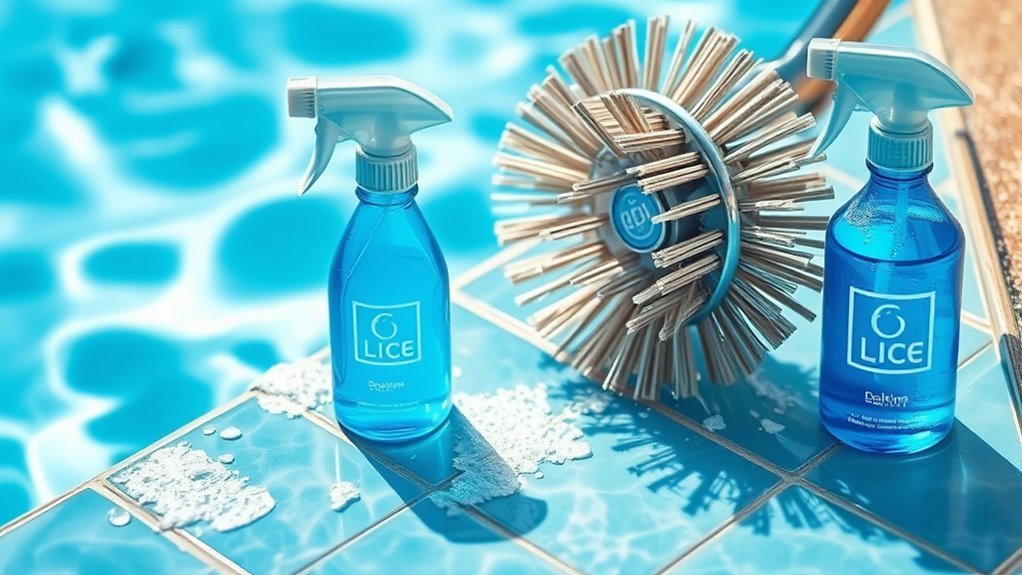
To effectively clean pool tile calcium, you’ll need a specific set of tools and chemicals that can tackle the buildup without damaging the surfaces. Start with durable cleaning brushes, which should have stiff bristles to reach into crevices. You’ll also require acidic cleaners designed for pool use; these will break down the calcium deposits efficiently.
| Tool/Chemical | Purpose |
|---|---|
| Cleaning Brushes | Scrub calcium deposits |
| Acidic Cleaners | Dissolve calcium buildup |
| Protective Gloves | Safeguard your hands |
| Bucket | Hold cleaning solution |
Having these tools and chemicals on hand will streamline your cleaning process, allowing you to maintain your pool’s aesthetic and functionality.
How to Clean:
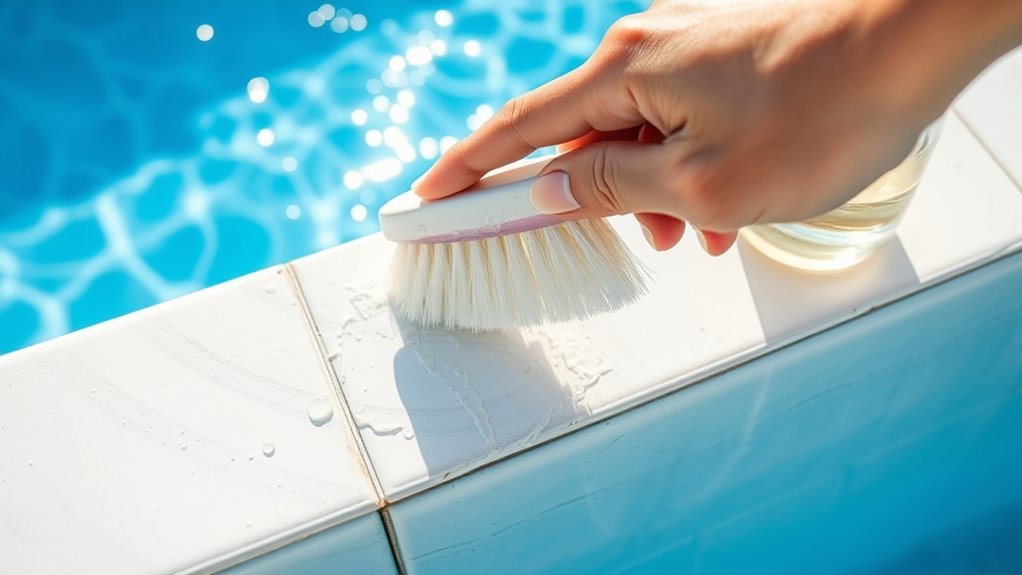
Step 1: Gather Your Supplies
- Collect all necessary tools and chemicals before starting the cleaning process. This includes:
- A cleaning solution specifically designed for calcium deposits
- A scrub brush with stiff bristles
- A pumice stone (for stubborn spots)
- A bucket for rinsing
- A hose or a source of water for rinsing
- Protective gloves and goggles to keep yourself safe from chemicals
Step 2: Apply the Cleaning Solution
- Choose a cleaning solution that is effective for calcium buildup.
- Apply the solution generously to the affected areas of the pool tiles.
- Allow the solution to sit for the recommended time as instructed on the product label. This waiting period is crucial for the solution to penetrate and break down the deposits effectively.
Step 3: Scrub the Tiles
- After the solution has had time to work, take your scrub brush.
- Begin scrubbing the tiles in circular motions, paying special attention to areas with heavy calcium buildup.
- Apply more pressure on stubborn areas, but be cautious to avoid damaging the tile surface.
Step 4: Use a Pumice Stone for Stubborn Spots
- If there are still visible calcium deposits after scrubbing, take a pumice stone.
- Gently rub the pumice stone on the stubborn spots, ensuring you do not scratch the tile surface.
- Work slowly and carefully to avoid damaging the tiles while effectively removing the deposits.
Step 5: Rinse Thoroughly
- Once you have scrubbed the tiles, it’s time to rinse the area.
- Use a hose or a bucket filled with clean water to thoroughly rinse off any remaining cleaning solution and loosened calcium deposits.
- Ensure that all residue is removed, as leftover chemicals can affect the pool water quality.
Step 6: Evaluate the Results
- After rinsing, take a moment to assess the cleanliness of your pool tiles.
- If some areas still show calcium buildup, you may need to repeat the cleaning process.
- Always ensure the tiles are completely clean to maintain the aesthetics and hygiene of your pool.
Step 7: Regular Maintenance
- To prevent future calcium buildup, consider establishing a regular cleaning schedule.
- Use a mild cleaning solution or vinegar for routine maintenance, and inspect the tiles frequently for any signs of buildup.
- Keeping up with regular cleaning will make it easier to manage calcium deposits in the long run.
Safety Consideration
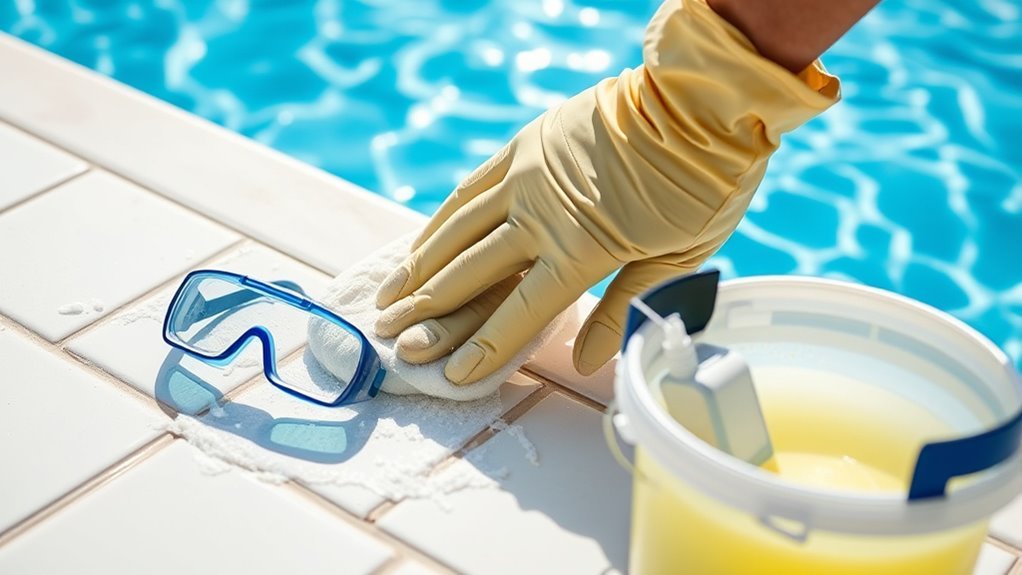
While cleaning pool tile calcium is essential for maintaining your pool’s appearance, safety should always be your top priority. Begin by wearing appropriate protective gear, including gloves, goggles, and a mask, to shield yourself from harmful chemicals and irritants. When handling cleaning solutions, make certain you’re in a well-ventilated area to minimize inhalation risks. Always read the labels on any chemicals you use, following the manufacturer’s instructions precisely to avoid dangerous reactions. Store chemicals securely, away from children and pets, and never mix different cleaning agents, as this can lead to toxic fumes. By adhering to these safety protocols, you’ll not only protect yourself but also enhance your freedom to enjoy a clean and beautiful pool environment.
Tips to keep clean for long time
After ensuring your safety while cleaning pool tile calcium, it’s important to implement strategies that will help maintain that cleanliness over time. Start by establishing a routine for regular maintenance; weekly brushing of tiles can prevent calcium buildup. Incorporate preventive measures such as using a quality pool cover to minimize debris and evaporation, which can lead to scaling. Monitor your pool’s pH and alkalinity, as balanced water chemistry reduces the likelihood of calcium deposits. Additionally, consider investing in a water softener to treat incoming water, further inhibiting mineral accumulation. By adhering to these practices, you’ll not only extend the life of your pool tiles but also enjoy a consistently clean and inviting swimming environment.
Frequently Asked Questions
How Often Should I Clean My Pool Tile for Calcium Buildup?
You should aim to clean your pool tile for calcium buildup at least once a month as part of your maintenance schedule. This cleaning frequency helps prevent significant buildup and keeps your pool looking pristine. However, if you notice excessive calcium deposits, you might need to clean more frequently. Regular inspections and adjustments to your cleaning routine will guarantee a sparkling pool and provide you the freedom to enjoy it without worry.
Can I Use Vinegar Instead of Commercial Cleaners?
Yes, you can use vinegar instead of commercial cleaners for calcium buildup. Think of vinegar as a gentle giant, effective yet safe. Its acidity helps dissolve calcium deposits, making it a viable alternative solution. However, you’ll need to scrub a bit more vigorously and repeat the process for tough stains. While vinegar’s effectiveness is commendable, for heavy buildup, you may still consider commercial options for a thorough clean.
What Causes Calcium Buildup on Pool Tiles?
Calcium buildup on pool tiles primarily comes from calcium sources like hard water, which contains high mineral content. Additionally, evaporation leaves these minerals behind, leading to deposits. To prevent this, regularly check your water chemistry and maintain balanced pH and alkalinity levels. Using a water softener can also help reduce calcium levels. By staying proactive with these prevention tips, you can minimize buildup and keep your pool tiles looking pristine.
Is It Safe for Pets During the Cleaning Process?
It’s generally not safe for pets during the cleaning process, especially if you’re using harsh chemicals. Many cleaning methods involve substances that can be harmful if ingested or inhaled by pets. To guarantee pet safety, keep them away from the pool area until all cleaning is complete and any residues have been thoroughly rinsed away. Always read product labels and consider eco-friendly options to minimize risks to your furry friends.
Will Cleaning Damage My Pool Tiles or Grout?
Cleaning won’t damage your pool tiles or grout if you choose the right methods and products. For tile maintenance, avoid harsh chemicals; instead, opt for pH-balanced cleaners that protect grout. Always test a small area first to guarantee compatibility. Regular maintenance can also prevent buildup, minimizing the need for aggressive cleaning. By being methodical in your approach, you can keep your pool looking great without compromising the integrity of your tiles or grout.


